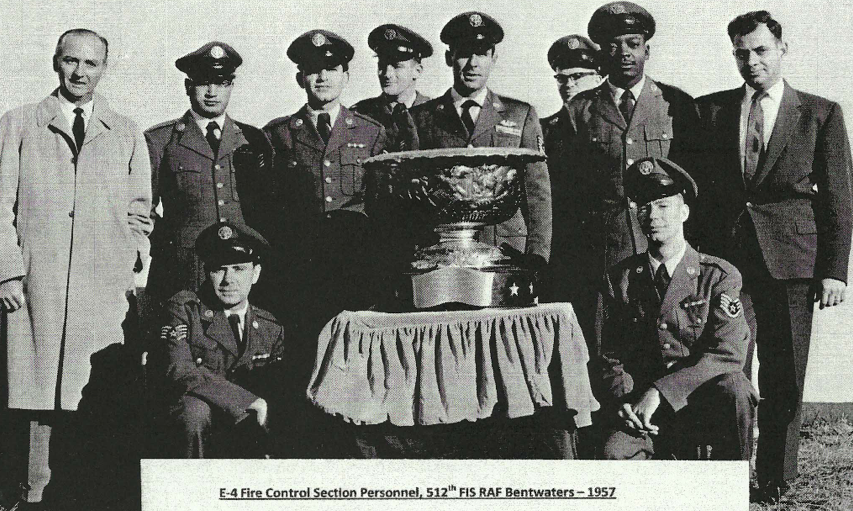The Beginning
In 1954 the U.S. deployed several Air Force fighter-interceptor units to the East coast of England. The Korean War had ended the year before, and a Westward attack was a possibility. The purpose of this deployment was to protect the U.K. by providing a means to interdict enemy air attack from across the North Sea. The 87th Fighter Interceptor Squadron at Sioux City, Iowa, was one of the units chosen to be deployed. The hot war was over and the cold war began. The aircraft chosen to re-equip the 87th FIS was the newer, larger, faster F-86D Sabre, known affectionately as the “Dog” because of its “D” designator’s position in the old phonetic alphabet (Able, Baker, Charlie, Dog, etc.). Undoubtedly, it was a formidable war machine. Which was exactly what we needed to perform guard duty over the North Sea. Every man in the unit was hand-picked from all the fighter outfits in the United States, as best suited for this deployment. The squadron was complete.
Soon after its deployment, the unit was redesignated the 512th Fighter Interceptor Squadron. No one yet knew that the 512th was to become famous, but it had all of the potential. The squadron was commanded by a WWII fighter ace named Mike Quirk, a colonel who earned his fame by flying fighters out of East Anglia, protecting U.S. bombers over Europe. His second-in-command was Frank Bohn, a major who gained his fame by flying fighters over WWII North Africa in a P-39 Airacobra, shooting up Rommel’s tanks with its 37mm cannon. Colonel Quirk’s maintenance officer was a real prize — a “take no nonsense” old captain by the name of Roy Sweigard who had been on the ship when Doolittle did Tokyo. The 512th pilots were a top notch group of young, recent grads from F-86D school with plenty of hours of practice. The backbone of any fighting organization, the senior noncommissioned officers, were experienced individuals on their second or third hitches. The lower ranking airmen were the best available, including a bunch of college boys. We were ready to go to work.
My sincere thanks to Dean Danley, historian of the association for bringing me back in time to the glory days of the 512th Fighter Interceptor Squadron. Without question, our pilots and ground support were the ‘best of the best’ during that era (1954-1957) while serving at Bentwaters Air Force Base in England. We jointly shared the base with the RAF Pilots and their crew members.
My journey back to yesteryear began while attempting to locate my close buddy, William W. Martin, while serving in the United States Air Force, from Basic Training at Sampson AFB, N.Y., on to our deployment at Bentwaters AFB in 1955. Repeated attempts to locate William “Bill” Martin through different resources always came up empty until, through the internet, I found several links on the 87th/512th Fighter Interceptor Squadron and the name of Dean Danley as the historian. Dean’s willingness to assist me in reigniting the proud memories of our squadron and the possibilities of locating William Martin gave me renewed hope that it might come to fruition in times past and present.
Some Significant History on the 512th Fighter Interceptor Squadron
Most of the information Dean Danley has furnished me is a result of his searching the archive riles of the 87th/512th FIS Association for history and persons of interest to me, with the approval of the officers of the association. Short of mentioning names of our pilots and ground support members, let me make it clear just how proud I was to be a part of this extraordinary group of airmen. I was honored to be affiliated with America’s finest. All too often we forget the greatness of these fine men. Pride, integrity, glory are all interwoven into each one’s fabric.
Allow me to flashback to late summer of 1953. Lieutenant Colonel Michael J. Quirk, a World War II double ace, took command, and the squadron transitioned to F-86Ds. The unit became combat-ready in record time, and as a result, in July 1954, it was alerted for overseas assignment to RAF Station Bentwaters, England, replacing another unit that had been programmed to go. This allowed but a short period to fill the unit with overseas-eligible personnel for shots, passports, etc., to relocate families and to pack squadron equipment for shipment. The personnel of the 87th FIS staged at Sioux City Air Base, Iowa, and departed by train on Dec. 11, 1954, en route to Staten Island, N.Y. We arrived at Staten Island on Dec. 13, 1954, and set sail on The USS General Patch Troop Ship the same day en route to South Hampton England, arriving on Dec. 20, 1954. Bentwaters was not prepared for the squadron. In fact, it was on Christmas break until New Year. Personnel quickly adapted to the English winter weather, Quonset huts and pot-bellied stoves. Aircraft arrived in January 1955, and after a short check-out, the unit was again combat ready. Unit integrity, esprit de corps and high morale prevailed. As part of the 406th Fighter Interceptor Wing at RAF Station, Manston, England, the squadron acquired an outstanding record in flying, maintenance, safety, and weapons proficiency. The squadron prided itself on concern for assigned personnel and for supporting its families scattered throughout the English countryside, learning new customs and coping with the English economy.
In September 1955, the 87th FIS was re-designated the 512th FIS and the 87th was inactivated. The 512th FIS had been part of the 86th Fighter Wing, Ramstein, and was located at Soesterberg, Holland. With this change, the 406th FIW again had had its World War 11 Squadrons – the 512th, 513th, and 514th. Without interruption, the 512th assumed the mission of the 87th FIS. The new unit insignia, which had been designated for the 87th, was resubmitted and approved for the 512th, the “Dragons.”
Cooperation and ingenuity were hallmarks of the squadron. A converted but complete with squadron insignia served as a runway control unit. While the squadron was practicing gunnery at Wheelus Field, Tripoli, those remaining at Bentwaters poured concrete for a high-speed taxiway as the new alert hanger.
Lieutenant Colonel John J. Ruettgers assumed command of the unit in September 1956, and the squadron continued its outstanding performance, being designated the “best in USAFE, winning the USAFE weapons meet at Wheelus Field and going on to represent USAFE and win the USAF weapons competition at Yuma AFB, Arizona in July 1957. For its achievement, the 512th became the proud winner of the Hughes Trophy as the “best Fighter Interceptor Squadron in the United States Air Force. The 1957 Hughes Trophy is a one-of-a-kind award honoring the 50th anniversary of the United States Air Force. When it was brought home to England, this large trophy — the bowl being 30 inches in diameter and 18 inches high, the base another 12 inches, and valued at $20,000 in 1957 was filled with vintage champagne, with the understanding that in the future, it would be used in that manner. The 512th had the most expensive punch bowl in the USAF. (All of the above information was graciously provided to me by Dean Danley, Historian). Thank you Dean.
Organizational Statement:
The 87th/512th Fighter Interceptor Squadron Association is an Organization of Veterans who during the years of 1954-1958 proudly served the nation as members of an Air Defense Fighter Interceptor Squadron serving in the United Kingdom (England) and other European Countries during the Cold War.
The link “Folded Wings” honors all of our deceased pilots and airmen who served in the 87th/ 512th FIS. It brought me back in time remembering all of these distinguished and time honored men whom I was privileged to serve with during my deployment at Bentwaters AFB. They will never be forgotten as they soar with the Eagles high above the blue skies. Requiem Pacem (rest in peace)
This poem says volumes about them:
In Memory
“They shall grow not old, as we that are left grow old;
Age shall not weary them, nor the years condemn.
At the going down of the sun and in the morning,
We will remember them”
Laurence Binyon (1869 – 1943)
Due to lack of attendance of aging members, the Association Reunions were discontinued during the 2011 Reunion (by vote) in Denver, Colorado.









